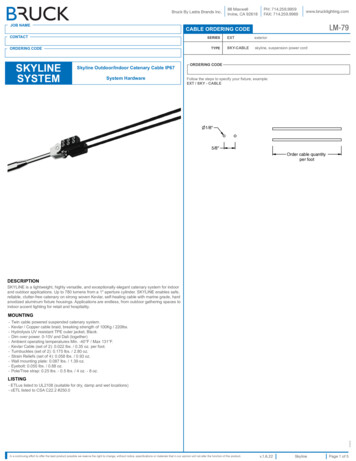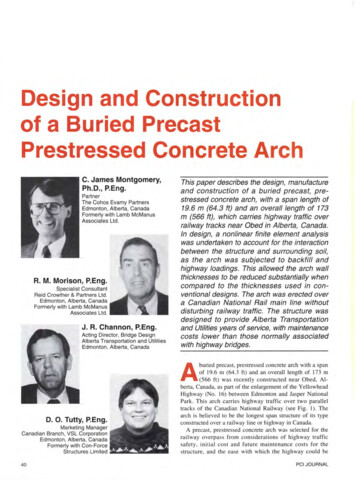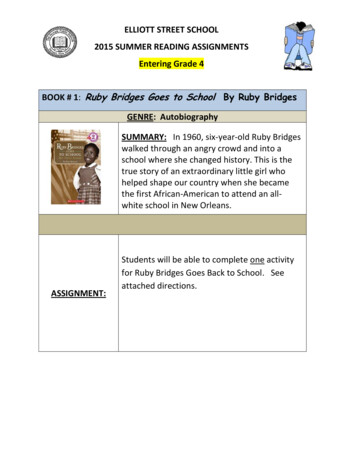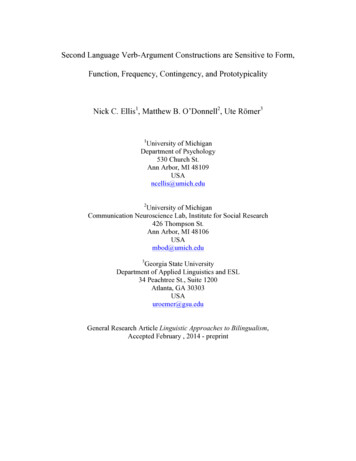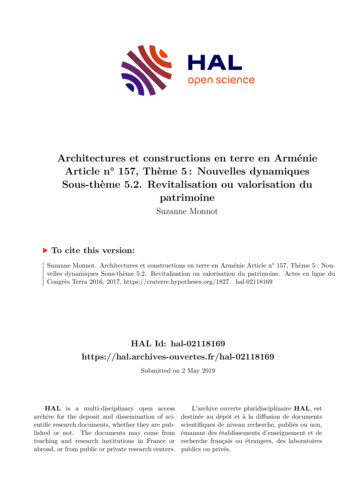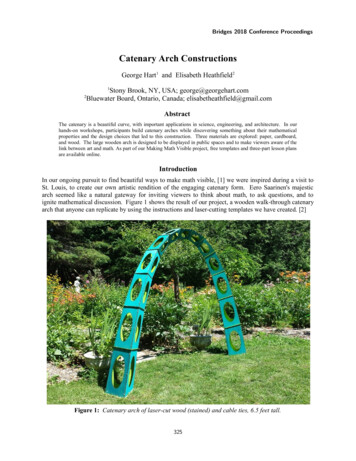
Transcription
Bridges 2018 Conference ProceedingsCatenary Arch ConstructionsGeorge Hart1 and Elisabeth Heathfield21Stony Brook, NY, USA; george@georgehart.comBluewater Board, Ontario, Canada; elisabetheathfield@gmail.com2AbstractThe catenary is a beautiful curve, with important applications in science, engineering, and architecture. In ourhands-on workshops, participants build catenary arches while discovering something about their mathematicalproperties and the design choices that led to this construction. Three materials are explored: paper, cardboard,and wood. The large wooden arch is designed to be displayed in public spaces and to make viewers aware of thelink between art and math. As part of our Making Math Visible project, free templates and three-part lesson plansare available online.IntroductionIn our ongoing pursuit to find beautiful ways to make math visible, [1] we were inspired during a visit toSt. Louis, to create our own artistic rendition of the engaging catenary form. Eero Saarinen's majesticarch seemed like a natural gateway for inviting viewers to think about math, to ask questions, and toignite mathematical discussion. Figure 1 shows the result of our project, a wooden walk-through catenaryarch that anyone can replicate by using the instructions and laser-cutting templates we have created. [2]Figure 1: Catenary arch of laser-cut wood (stained) and cable ties, 6.5 feet tall.325
Hart and HeathfieldThe St. Louis Gateway Arch is a giant mathematical drawing in the sky. Every day, thousands ofvisitors are attracted by its beauty, compelled to step inside and to physically follow its arc upwards. Theinviting form of the catenary has fascinated humans for centuries, going back to Galileo who famouslypuzzled over its mathematical properties. After the invention of calculus, both the upward orientation ofa catenary arch and the hanging form of a chain could be precisely understood. The suspended version ofa catenary can be found all around us, from the delicate threads of a spider web, to the ubiquity oftelephone wires, to the rusted anchor chain of a battleship. In contrast, true catenary arches are relativelyrare; before Eero Saarinen's monumental St. Louis example, they mainly occurred when stone masons orarchitects such as the visionary Antonio Gaudi, consciously upended the familiar hanging shape. [3, 4, 5]We conceived of various ways that we could add an artistic body to the underlying mathematicalbones of the curve. The pure catenary is just a line of zero thickness, but we needed to flesh out itssubstance so it could stand up and have the presence and physicality of a sculptural object. The first stepwas to design software that allowed us to manipulate many parameters and make artistic decisions as weviewed various hypothetical renditions on the screen. This led us to produce templates for a paperversion that can be assembled as a real concrete object. From there, it was a natural step to scale it up to alarger cardboard arch, which convinced us of the worth of our artistic choices. We then created a full sizewooden sculpture large enough to walk through. It stands on its own as an artistic manifestation of themathematical concept.One aspect which makes the catenary arch so captivating is that it has deep mathematical as well asartistic beauty. It can be enjoyed for its elegant clean lines and aesthetic minimalism or for its fascinatingrole in mathematical physics. A hands-on model can serve as a wonderful educational tool to demonstratethat the catenary is the optimal shape for an arch that carries its own weight. It has been used as anexhibit in many science museums, where visitors can build an arch with self-supporting blocks. Whenconstructing it, the builder discovers that the weight of the arch is directed along its length, so nosideways force exists to slide the blocks apart where they rest on each other. This requires a beautifulcurve, similar to a parabola, yet subtly different. Educators will find this to be a natural opportunity toexplain that a parabola is a quadratic polynomial, while the catenary is in the exponential curve family.Fully understanding why the catenary is the shape of a hanging chain and has the optimal properties itdoes requires drawing a force diagram then applying a bit of calculus, something that is generally omittedin science museum exhibits. A complete derivation can be found in university-level math andengineering textbooks or conveniently online at Wikipedia. [5]The educational possibilities presented by the catenary arch naturally led us to incorporate it into ourMaking Math Visible project. Its mathematical depth lends itself well to hands-on activities that illustratethe intersection of math and art. Our templates and lesson plans are freely available online [2] and wewelcome people to recreate them in classrooms, schools, and public spaces. Educators will find that theyhave many entry points, which allows them to adapt the activities to the level of the participants. We usea three-part lesson model to first activate students' thinking in a “minds-on” exercise, followed by themain construction activity, and concluding with a consolidation to ensure mathematical concepts areclearly understood and retained.Design and CustomizationCustomizing the catenary is a good exercise in 3D design iteration. We wrote a small program inMathematica [6] to render many variations for the skin of the arch, allowing us to explore a sizable designspace while thinking about aesthetics, strength, complexity, size, ease of assembly, and the constraint thatthe largest piece must not be too large to fit on our laser-cutter. In the end, after all the parameters weretweaked to our liking, the program output the face templates in a format we could adapt for laser-cutting.Figure 2a shows a rendering of a possible design of a thirteen-section arch in which the tube has aconstant square cross section. It is surprisingly ugly and blocky, in part because it does not taper down toa thinner cross section at the top. Saarinen's design, Figure 3, is elegantly tapered, making it feel solidly326
Catenary Arch Constructionsanchored to the earth while gracefully reaching for the sky. Figure 2b shows the improvement affordedby a taper, while experimenting briefly with a pentagonal cross section instead of a square. In addition,diamond-shaped openings are introduced.Figure 2: Four possible realizations of a catenary arch: (a) square in cross-section, un-tapered,with no openings; (b) pentagonal with diamond openings; (c) triangular with rectangularopenings and 18 segments; (d) triangular, pointing upward, with small elliptical openings.Some sort of openings are required when assembling the wood panels with cable ties, in order to accessthe interior and to thread the ties through small holes. However, the angularity of these diamond-shapedholes is an unfortunate choice that conflicts with the smoothness of the curve. In Figure 2c, thepentagonal tube idea has been abandoned and simplified to an equilateral triangle, the diamond openingsare tamed a bit in becoming rectangular, and the number of segments has been increased to eighteen.These openings are only a slight improvement over the diamonds and the many segments would requiresignificantly more building time, yet do not add much to the smoothness of the curve. However,327
Hart and HeathfieldSaarinen's choice of a triangular cross section is clearly an aesthetically pleasing simplifying step. InFigure 2d, we experiment with the rotational “phase” of the cross section by briefly considering twistingthe triangle so there is a ridge line along the outside and peak of the arch. This feels overly sharp andknife-like, again confirming Saarinen's eye for design. We also experimented with elliptical portholesminimally sufficient for accessing the interior, however their small size was awkward and distracted fromthe overall design. In the end, we simply had no choice but to copy the tapered, triangular cross section,phased as in St. Louis. We enlarged the elliptical windows, making them light and open to allow interioraccess, while structurally reinforcing the corners as fillets.An interesting design question lies in the lengths of the individual segments. As we were working withflat pieces of plywood, the underlying smooth curve had to be approximated with discrete polygons. Evenafter deciding on the number of sections, the question remained of precisely where the slices should bemade. For visual reasons, the sections near the top, where the curvature is greater and the cross section isthinner, had to be shorter, but how much shorter? There are a number of ways one might try to approachthis rationally with a mathematical principle of design. Instead we cobbled together an interpolatingfunction that smoothly varied between a short-enough segment at the apex and one that just filled the 12by-24-inch bed of our laser cutter at the bottom.Another set of design issues concerns the triangular bracing pieces which serve as “floors” where thethirteen modules join. In our wood catenary, there are fourteen of these, including the two ends,analogous to the fourteen fence-posts required to hold thirteen lengths of fence. (In the paper and woodversions, there are twenty-six triangles, as each end of each module is capped individually.) They aresmaller near the top, in proportion to the taper. Functionally, they serve to align the side panels and lockeverything rigidly. We believe they are necessary for strength, but haven't experimented with omittingthem. Visually, they emphatically demarcate the straight sections, making explicit the discreteapproximation to the underlying curve. Each slice is orthogonal to the catenary, except the two extremecuts, which are horizontal, so the arch can rest stably on the floor. As a practical matter, the woodtriangles are hollow, which allows them to be nested for laser-cutting and provides additional access tothe interior during the assembly.Figure 3: Gateway Arch in St. Louisby Eero Saarinen, 630 feet tall.Figure 4: 3D printed model of our final catenary design, 6inches tall.328
Catenary Arch ConstructionsAn additional engineering detail is that although the arch balances beautifully on its own, we designeda simple base on which to attach the large wood version. This provides stability and safety if peoplebump into it. The base is basically just a sheet of plywood with small holes for cable ties to loop through,positioned to replace the two horizontal triangle brace pieces at the bottom of the arch. It also serves tofix the position of the two ends with the proper spacing.Finally, with the design programmed into Mathematica, it was relatively straightforward to also producean STL file suitable for 3D printing a miniature model of the design. Figure 4 shows a six-inch tallplastic version made on a Makerbot fused deposition machine. The STL file can be downloaded andreplicated as an educational model. [7]Paper CatenaryHeavy paper such as card stock is an inexpensive medium that is versatile, widely available, and easy towork with. Students of all ages can make surprisingly complex structures just using paper, scissors, glue,and tape. The first of the three versions presented here is a paper arch, 18 inches tall (48 cm), made ofthirteen modules. Assembling the pieces and balancing them provides a fun dexterity challenge that canbe adapted to different skill levels. Getting it to stand requires very precise fabrication and collaborativeconstruction with four or more hands. Given our access to laser cutters, we were able to fabricateprecisely cut pieces with elliptical openings. If working with scissors however, the openings could beomitted. Assembling it is an exercise in teamwork and communication that conveys a sense of theimportance of careful engineering.When we have tried this with student groups, we have observed their enormous satisfaction uponcompletion. Figure 5 shows the separate pieces under construction and Figure 6 shows the paper catenaryin its assembled form. Note that the thirteen separate pieces are just resting on each other, held togetherby their own weight, not glue or tape. A light touch or breeze will cause the construction to collapse.Participants typically require many attempts before they can get everything to balance just right, whichmakes the moment of success all the more joyful.Figure 5: Paper catenary assembly.Figure 6: Paper catenary assembled.329
Hart and HeathfieldWe developed a detailed three-part lesson plan that teachers can access and adapt to their student'slevel. It includes a complete materials list and the necessary templates. The workshop can be presentedas a simple hands-on construction that merely familiarizes students with the notion of a catenary, or it canbe a much deeper foray into mathematics, for example, comparing the formula of a parabola with theformula of a catenary and considering their asymptotic differences.Cardboard CatenaryIn our experience developing hands-on activities, we have repeatedly observed that participants greatlyenjoy applying newly acquired knowledge to larger-scale challenges. Building a scaled-up version of aproject like the paper catenary consolidates understanding and increases engagement. So it was naturalfor us to design a human-size arch, which led us to choose cardboard as the appropriate material.Cardboard is a surprisingly strong, durable, and affordable medium. We have found that if students havealready made the paper version, you can simply hand them the cardboard pieces with some rolls ofpacking tape and they need no further instruction. It is a natural example of linear scaling andproportional reasoning. A single four-foot tall cardboard catenary suffices for a class-size group, becausethe thirteen modules can be built in small teams. The result is a challenge that can be delightfullyknocked down and rebuilt over and over again, much like a science museum exhibit. Figure 7 shows thatthe cardboard catenary can remain as a natural accoutrement in a classroom setting throughout the year.Accurately cutting cardboard sheets into the required components is best done with a laser cutter. Werealize that many educators do not yet have access to this technology, but we are optimistic that lasercutters will become more and more available in the near future. Meanwhile, the template can be tracedand cut with a knife.Figure 7: The cardboard catenary, 4.5 feet tall, fits well in a classroom environment.330
Catenary Arch ConstructionsWood CatenaryWood offers more substance and permanence than mere paper or cardboard when making a work of art.It provides strength and a surface texture that adds to the overall visual and tactile appeal. Wood can bebeautifully stained, adding yet another dimension to the visual experience. We chose to use laser-cutBaltic birch plywood to construct a seven-foot tall catenary arch that is an homage to Saarinen's sculpturein the sky. Figure 8 gives a sense of its graceful presence in a natural setting. Its fluid line seems toeffortlessly emerge from and re-enter the Earth, while the ellipsoidal openings are suggestive of the chainfrom which the catenary was originally conceived.While based on the same underlying design as the paper and cardboard arches, this version ispermanently held together. We conceive of it more as an artwork to be exhibited in a gallery or sculpturegarden than as a puzzle to be repeatedly assembled. The components are easily portable, so it can beerected as a sort of pop-up math/art installation that gets people engaged in mathematical conversations.During construction, its modules are joined with cable ties, but afterward the beauty of the underlyingmath is intended to be appreciated visually, rather than as an educational hands-on activity. Figure 9shows that it also makes a great entryway into a reading nook in a classroom.In Figure 8 the arch is unstained, giving it a very natural look. However, we have found that applyingwater-based stain, as shown in Figures 1 and 9, adds a certain richness and visual impact.Figure 8: Wooden catenary on the beach at sunset. 6.5 feet tall.331
Hart and HeathfieldFigure 9: Wooden catenary as entrance to classroom reading nook. 6.5 feet tall.Summary and ConclusionsWe look at the world as artists, but always maintain our educational lens. Catenaries and parabolas areusually experienced as line drawings in the world of abstract mathematics. Saarinen's genius lies in partin creating a solid, tangible, imposing monument, yet keeping the quality and simplicity of a line. Ourgoal in this project was to keep some of that artistry while giving people a very personal and tactileexperience of an abstract mathematical concept on a manageable scale. A physical catenary modelshould expose the catenary's inherent beauty while preserving its minimalist essence.Part of the power of mathematical art is how it can penetrate people's field of vision in a casual wayand implant mathematical ideas that they may otherwise never encounter. If the catenary curve onlystayed on paper in textbooks, the general public would never have opportunity to experience it in anyway. Artists like Gaudi and Sarrinen have delighted the public with these forms, however one has totravel to particular sites to see their work. By providing catenary-based experiences through smallersculptural forms, we hope to familiarize people with the idea that the beauty of math is all around them.They will hopefully become sensitized to see how math, art, and engineering combine in the casual curveof a spiderweb or the everyday dangle of a power cord.AcknowledgmentsWe thank all the teachers and students who helped us test these activities.References[1] G. Hart and E. Heathfield. “Making Math Visible.” Bridges Conference Proceedings, Waterloo,Canada, 2017, pp. es2017-63.html[2] G. Hart and E. Heathfield. Making Math Visible, http://MakingMathVisible.com[3] G. Kaplan. “The Catenary: Art, Architecture, History and Mathematics.” Bridges ConferenceProceedings, London, England, 2008, pp. dges2008-47.html[4] E. Conversano et al. “Geometric Forms that Persist in Art and Architecture.” Bridges ConferenceProceedings, Coimbra, Portugal, 2011, pp. dges2011-463.html[5] “Catenary.” Wikipedia, https://en.wikipedia.org/wiki/Catenary[6] Mathematica. http://www.wolfram.com[7] G. Hart, “Rapid Prototyping Web Page.” http://georgehart.com/rp/rp.html332
The catenary is a beautiful curve, with important applications in science, engineering, and architecture. In our hands-on workshops, participants build catenary arches while discovering something about their mathematical properties and the design choices that led to this construction. Three materials are explored: paper, cardboard, and wood.
